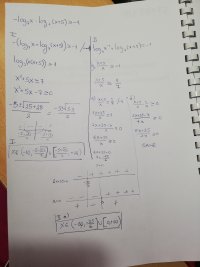I think both ways are correct, why did I get such different answers then?
- Thread starter Loki123
- Start date
D
Deleted member 4993
Guest
Nice presentation!I tried to solve it two different ways and actually got different results. I can't pinpoint a mistake. So what's going on? View attachment 30414
However in the second line you made a mistake.
If x > y then (-x) < (-y)
Harry_the_cat
Elite Member
- Joined
- Mar 16, 2016
- Messages
- 3,782
In solution II, the (x+5) needs an index of -1 also in the first line.
My goodness. So many places to go wrong. Tricky problem.
Method 1
−{log7(x)+log7(x+5)}≥−1⟹log7(x)+log7(x+5)≤7.
Multiplying by a negative number reverses an inequality.
It is true that
x2+5x−7=0⟹x≤2−5−53<0 or x≤2−5+53.
And from that, one can deduce
x2+5x−7≤0⟹x∈(−∞, −2−5−53 ]⋃[ 0, 253−5 ].
But we started with log7(x). Can x be less than or equal to 0?
Thus we get
0<x≤253−5.
Method II
−log7(x)−log7(x+5)≥−1⟹log7(x1)+log7(x+51)≥log7(71)⟹
log7(x∗(x+5)1∗1)≥log7(71)⟹log7(x2+5x1)≥log7(71)⟹x2+5x1≥71.
Does cross multiplying in this case reverse the inequality? No. Why not in this specific case?
So we get to
7≥x2+5x⟹x2+5x≤7⟹x2+5x−7≤0.
The two methods (if done without error) do converge. But cross multiplication in inequalities is super-tricky. I try to avoid it.
Method 1
−{log7(x)+log7(x+5)}≥−1⟹log7(x)+log7(x+5)≤7.
Multiplying by a negative number reverses an inequality.
It is true that
x2+5x−7=0⟹x≤2−5−53<0 or x≤2−5+53.
And from that, one can deduce
x2+5x−7≤0⟹x∈(−∞, −2−5−53 ]⋃[ 0, 253−5 ].
But we started with log7(x). Can x be less than or equal to 0?
Thus we get
0<x≤253−5.
Method II
−log7(x)−log7(x+5)≥−1⟹log7(x1)+log7(x+51)≥log7(71)⟹
log7(x∗(x+5)1∗1)≥log7(71)⟹log7(x2+5x1)≥log7(71)⟹x2+5x1≥71.
Does cross multiplying in this case reverse the inequality? No. Why not in this specific case?
So we get to
7≥x2+5x⟹x2+5x≤7⟹x2+5x−7≤0.
The two methods (if done without error) do converge. But cross multiplication in inequalities is super-tricky. I try to avoid it.
Last edited:
oh yeah, i missed that. However, even when I correct that the two results do not match.Nice presentation!
However in the second line you made a mistake.
If x > y then (-x) < (-y)
I understand the process. However what I don't understand is why I can't only give index -1 to x and solve by formula loga - logb.My goodness. So many places to go wrong. Tricky problem.
Method 1
−{log7(x)+log7(x+5)}≥−1⟹log7(x)+log7(x+5)≤7.
Multiplying by a negative number reverses an inequality.
It is true that
x2+5x−7=0⟹x≤2−5−53<0 or x≤2−5+53.
And from that, one can deduce
x2+5x−7≤0⟹x∈(−∞, −2−5−53 ]⋃[ 0, 253−5 ].
But we started with log7(x). Can x be less than or equal to 0?
Thus we get
0<x≤253−5.
Method II
−log7(x)−log7(x+5)≥−1⟹log7(x1)+log7(x+51)≥log7(71)⟹
log7(x∗(x+5)1∗1)≥log7(71)⟹log7(x2+5x1)≥log7(71)⟹x2+5x1≥71.
Does cross multiplying in this case reverse the inequality? No. Why not in this specific case?
So we get to
7≥x2+5x⟹x2+5x≤7⟹x2+5x−7≤0.
The two methods (if done without error) do converge. But cross multiplication in inequalities is super-tricky. I try to avoid it.
Oh you could do that. Again though you must do it correctly.I understand the process. However what I don't understand is why I can't only give index -1 to x and solve by formula loga - logb.
−log7(x)−log7(x+5)≥−1⟹(−1)log7(x)−log7(x+5)≥(−1)log7(7)⟹
log7(x1)−log7(x+5)≥log7(71)⟹log7⎝⎜⎜⎛x+5x1⎠⎟⎟⎞≥log7(71)⟹
log7⎝⎜⎜⎛1x+5x1⎠⎟⎟⎞≥log7(71)⟹log7(x1∗x+51)≥log7(71)⟹
log7(x2+5x1)≥log7(71)⟹x2+5x1≥71.
But what you cannot do is to just change a minus sign into a plus sign as you did in line 1 of your method II.
Thank youu, I can't believe I didn't see that.Oh you could do that. Again though you must do it correctly.
−log7(x)−log7(x+5)≥−1⟹(−1)log7(x)−log7(x+5)≥(−1)log7(7)⟹
log7(x1)−log7(x+5)≥log7(71)⟹log7⎝⎜⎜⎛x+5x1⎠⎟⎟⎞≥log7(71)⟹
log7⎝⎜⎜⎛1x+5x1⎠⎟⎟⎞≥log7(71)⟹log7(x1∗x+51)≥log7(71)⟹
log7(x2+5x1)≥log7(71)⟹x2+5x1≥71.
But what you cannot do is to just change a minus sign into a plus sign as you did in line 1 of your method II.

